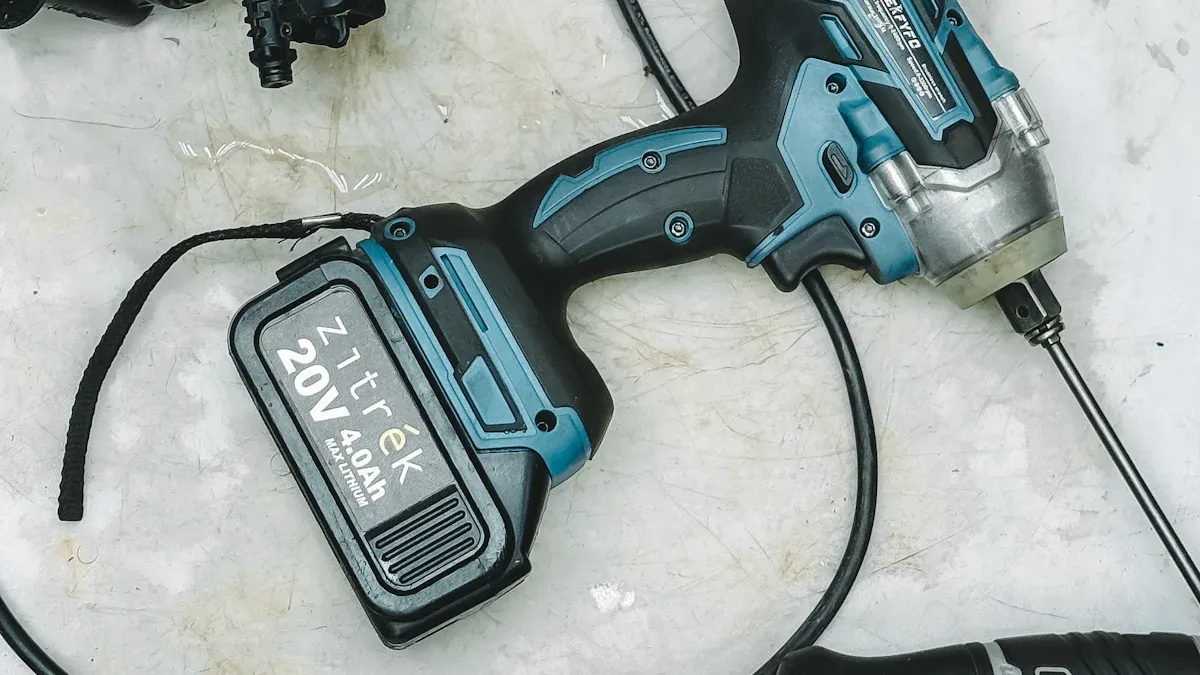
When considering a 4Ah vs 5Ah battery comparison, you can use a 5Ah battery in place of a 4Ah battery as long as the voltage and size match. The 5Ah battery provides a higher capacity, resulting in longer runtime and enhanced performance for systems such as medical devices or security infrastructure. Always verify the differences in terminal types and ensure safe installation for the user.
Key Takeaways
You can replace a 4Ah battery with a 5Ah battery if the voltage, size, and terminal type match, gaining about 25% longer runtime and better performance.
Always check terminal types and battery dimensions before installation to ensure safety and proper fit, avoiding connection problems or hazards.
Matching voltage is crucial to protect your device and maintain battery life; never use a battery with a different voltage than recommended.
Part 1: 4ah vs 5ah battery comparison

1.1 Capacity difference
The amp-hour (ah) rating serves as a direct measure of a battery’s charge capacity and energy storage. In a 4ah vs 5ah battery comparison, both batteries maintain the same voltage, but the 5ah battery offers a higher capacity. This means you can expect the 5ah battery to deliver more current for a longer period or sustain a lower current for an extended duration. According to manufacturer specifications, the main difference between 4ah and 5ah batteries lies in their amp-hour rating, which impacts runtime rather than voltage or power output. The 5ah battery contains more chemical components, resulting in about 25% more energy storage and a corresponding increase in runtime.
For B2B applications, such as medical devices, robotics, security systems, infrastructure backup, consumer electronics, and industrial automation, this higher capacity translates to longer operational periods between charges. For example, a 40V 4ah battery provides 160 watt-hours, while a 40V 5ah battery delivers 200 watt-hours—a 25% increase in available energy. This difference can be critical in sectors where uninterrupted power is essential.
Battery Type | Voltage (V) | Ah Rating | Watt-Hours (Wh) | Typical Application |
|---|---|---|---|---|
4ah battery | 12 / 24 / 40 | 4 | 48 / 96 / 160 | Security, Medical, Robotics |
5ah battery | 12 / 24 / 40 | 5 | 60 / 120 / 200 | Security, Medical, Robotics |
Tip: Always match the voltage and ah rating to your device’s requirements to optimize performance and battery longevity.
1.2 Runtime difference
The runtime of a battery refers to how long it can power a device before requiring a recharge. In the 4ah vs 5ah battery comparison, the 5ah battery provides approximately 20-25% longer runtime than the 4ah battery, assuming both operate at the same voltage. For instance, in security alarms, UPS systems, and medical equipment, a 12V 4ah battery typically lasts 4-5 years, while a 5ah battery of the same size extends runtime by about 20%. This longer runtime can be crucial for critical infrastructure and industrial applications where downtime is not acceptable.
In electric scooters and similar devices, runtime scales almost linearly with the ah rating. If you use a 5ah battery instead of a 4ah battery, you can expect roughly 25% more operational time per charge. This proportional increase benefits B2B users who rely on cordless power tools or mobile equipment for extended shifts.
Note: Lithium battery chemistries, such as lithium-ion, LiFePO4, lithium-polymer, and solid-state battery, often deliver more effective runtime per ah than traditional lead-acid batteries due to their flat voltage curve and efficient energy delivery.
1.3 Physical difference
When comparing the physical characteristics of 4ah and 5ah batteries, you will find that most models share identical dimensions, allowing for easy interchangeability in devices that support their size. However, the 5ah battery usually weighs 10-20% more than the 4ah battery due to the increased volume of active materials required for higher capacity. This slight weight increase may affect handling in portable applications, but it rarely impacts stationary B2B installations.
Dimension | Measurement (inches) | Weight (lbs) |
|---|---|---|
Length | 3.54 | |
Width | 2.76 | |
Height | 3.98 | |
Height with terminals | 3.8 | |
Weight (4ah) | 1.2 | |
Weight (5ah) | 1.3-1.4 |
Terminal types also play a vital role in battery compatibility and safety. Both 4ah and 5ah batteries may use F1 or F2 terminals. The F1 terminal measures 0.187 inches wide, while the F2 terminal is 0.250 inches wide. Using the wrong terminal size can cause connection issues or even safety hazards, such as sparking or short circuits. Adapters are available to convert between F1 and F2 terminals, but you should always verify the terminal type before installation to ensure a secure fit and safe operation.
Terminal Type | Width (inches) | Common Battery Sizes | Compatibility Notes |
|---|---|---|---|
F1 (T1) | 0.187 (3/16″) | 4ah and 5ah batteries | Smaller width; adapters available |
F2 (T2) | 0.250 (1/4″) | 4ah and 5ah batteries | Larger width; adapters available |

Alert: Always check terminal compatibility before replacing a battery to avoid connection problems and ensure user safety.
Part 2: Battery compatibility

2.1 Voltage
You must always match the voltage of your replacement battery to the original specification. Devices in medical, robotics, and security sectors rely on precise voltage to function safely and efficiently. Using a battery with a different voltage can cause several issues:
Overvoltage may lead to overheating, swelling, or even fire hazards.
Undervoltage can result in device malfunction, unexpected shutdowns, or data loss.
Voltage instability shortens battery life and increases the risk of thermal runaway.
Manufacturers design lithium battery packs to operate within a specific voltage range. While some consumer devices tolerate minor variations, B2B applications demand strict adherence to voltage requirements. Battery Management Systems (BMS) in lithium packs help regulate voltage, but you should never exceed the recommended range. Always consult your device manual or technical documentation before installing a new battery.
Tip: Matching voltage ensures optimal performance and protects sensitive electronics from damage.
2.2 Terminal types
Terminal compatibility is critical for safe installation and reliable operation. Lithium battery packs for industrial and infrastructure use often feature different terminal types, such as Faston Tabs, Nut & Bolt, or Threaded Terminals. To identify the correct terminal type:
Inspect your current battery’s terminals and note their shape and size.
Check technical specifications or product images for both the existing and replacement batteries.
Match the terminal type exactly—mixing types like SAE and JIS can cause loose connections and safety hazards.
Use color coding (red for positive, black for negative) to confirm polarity.
You should never force incompatible terminals together. Proper terminal matching prevents connection issues and reduces the risk of short circuits or sparks. For more on installation safety and terminal compatibility, always refer to your device’s technical documentation.
2.3 Size
Physical size plays a major role in battery compatibility. Most 4Ah and 5Ah battery models share standard dimensions, allowing for straightforward replacement in B2B equipment. However, you must confirm that the new battery fits securely in the compartment. Even a small difference in size can lead to poor connections or installation hazards.
Battery Capacity | Dimensions (inches) | Dimensions (mm) | Terminal Type |
|---|---|---|---|
4Ah | 3.54 x 2.76 x 3.98 | 90 x 70 x 101 | F1 (T1) |
5Ah | 3.54 x 2.76 x 3.98 | 90 x 70 x 101 | F1 (T1) |
Always verify the compartment size and terminal alignment before installing a 5ah battery. This step ensures a secure fit and maintains the safety and performance of your lithium battery pack.
Alert: Never install a battery that does not match the original size or terminal type. This can compromise device safety and operational reliability.
When you replace a 4Ah battery with a 5Ah battery, you gain longer runtime and improved reliability for critical systems. Always confirm voltage, size, and terminal type before switching.
For medical, robotics, or security applications, select the battery that matches your device’s needs, usage duration, and compatibility.
Experts recommend:
Upgrade to a 5Ah battery for continuous or heavy-duty use.
Use terminal adapters if needed for proper fit.
Consider weight and cost differences for your application.
Feature | 4Ah Battery | 5Ah Battery |
|---|---|---|
Runtime | Shorter | Longer |
Portability | Higher | Lower |
Compatibility | F1/F2 | F1/F2 |
FAQ
1. Can I use a 5Ah lithium battery pack in place of a 4Ah for medical or industrial equipment?
Yes, you can use a 5Ah lithium battery pack if voltage, size, and terminal type match. You gain longer runtime, which benefits critical medical and industrial operations.
2. Will switching from 4Ah to 5Ah affect device safety or performance?
You maintain device safety and performance by matching voltage and terminal type. Always follow manufacturer guidelines for lithium battery packs in robotics, security, or infrastructure systems.
3. Where can I get expert advice on lithium battery pack upgrades for B2B applications?
You can consult Large Power’s technical team for tailored solutions. Request a custom battery consultation here. Their experts support medical, robotics, and industrial sectors.






